LAB REPORT
Science and Technology Making Headlines
Nov. 17, 2023


The debut of NNSA’s Commodity Technology Systems-2 (CTS-2) computing clusters Dane (left) and Bengal (right) on the Top500 List of the world’s most powerful supercomputers brings the total of Lawrence Livermore National Laboratory-sited systems on the list to 11, the most of any supercomputing center in the world. Photos by Garry McLeod.
Setting a new benchmark
Three of the newest National Nuclear Security Administration (NNSA) commodity computing clusters recently deployed at Lawrence Livermore National Laboratory (LLNL) and Sandia National Laboratories are among the most powerful supercomputing systems in the world, Top500 organizers announced Monday.
Funded under the second Commodity Technology Systems contract by NNSA’s Advanced Simulation and Computing program, the machines sited at LLNL — named Dane and Bengal — began performing key modeling and simulation functions for the NNSA’s stockpile stewardship mission in mid-2023.
The debut of Dane, a 7.041 petaFLOP (slightly more than 7 quadrillion calculations per second) cluster at No. 108 and the 6.134 petaFLOP Bengal at No. 129, brings the total of LLNL-sited systems on the Top500 List to 11, the most of any supercomputing center in the world.

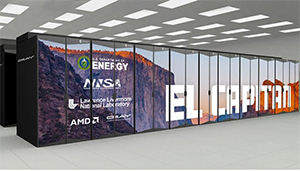
With its advanced computing and graphics processing units (CPUs/GPUs) developed by AMD, El Capitan’s peak performance is expected to exceed 2 exaFLOPS, which would make it the fastest supercomputer in the world when it is deployed in 2023. Illustration courtesy of Hewlett Packard Enterprise.
El Capitan on its way to the top
The Frontier supercomputer at Oak Ridge National Laboratory, powered by AMD EPYC processors and Instinct accelerators, remains the fastest computer in the world — for the fourth list in a row. Providing a blend of the best performance and leadership energy efficiency, Frontier continues to drive impactful science through its first full year of user operations. The latest scientific projects on Frontier include new research on power grid optimization, new designs on airplane engines for better efficiency and capabilities as well as two out of six finalists for the Gordon Bell award.
The second exascale-class supercomputer to be powered by AMD, El Capitan, has started its installation process at Lawrence Livermore National Laboratory. The system will be powered by the forthcoming AMD Instinct MI300A APU, which is the first data center APU to combine CPU and GPU cores and high-bandwidth memory, all in a single package. This innovative design is anticipated to provide dramatic increases in both energy efficiency and performance. When it comes online, El Capitan is expected to exceed two exaflops of double precision performance, becoming the second AMD powered supercomputer to surpass the exaflop barrier. You can see more about El Capitan at this video from Lawrence Livermore National Laboratory.
“We are making excellent progress on the installation of El Capitan, which will clearly be one of the world's best computing systems,” said Bronis R. de Supinski, the chief technology officer for Livermore Computing at Lawrence Livermore. “This enormous undertaking of multiple partners is creating a system that will enable our scientists to achieve results which they previously could only dream about. El Capitan will offer incredible programmability, performance and energy efficiency through its use of the AMD Instinct MI300A APUs, virtually eliminating the challenges of repeatedly moving data between CPUs and GPUs, thus helping us achieve our mission.”

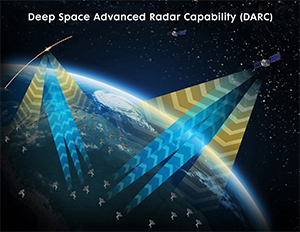
A artist's concept illustration of the Deep-Space Advanced Radar Capability, or DARC. Image courtesy of Northrop Grumman.
It’s out of this world
The Space Force’s Space Systems Command selected several startups and universities to participate in a new accelerator program focused on enhancing space domain awareness — or the ability to detect, characterize and understand activity in space.
The startups include True Anomaly, Katalyst Space Technologies, HEO, DigitalArsenal.io and Intrack Radar Technologies. From academia, the Space Force selected the Yale Undergraduate Aerospace Association, the University of Colorado Boulder, and the University of Colorado Colorado Springs. Other organizations supporting the project are Lockheed Martin, MITRE and Lawrence Livermore National Laboratory.
The program aims to leverage emerging commercial capabilities to help the Space Force better monitor objects and events in orbit. Space is becoming increasingly congested and contested. Space domain awareness is a complex problem and industry needs to help solve it.
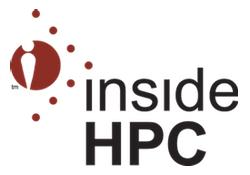
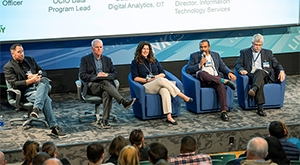
During the Data Days’ Data Leadership Panel, (pictured l-r) Department of Energy Chief Data Officer Rob King, Sandia National Laboratories Chief Data Officer Tom Trodden, National Nuclear Security Administration Office of the Chief Information Officer Data Program Lead Erica Vosseller, Nevada National Nuclear Sites Data Lead Krams Ramasubramanian and Pacific Northwest National Laboratory Data Architect Larry Seid discussed “establishing a data culture.” Photo by Blaise Douros/LLNL.
Data and data and more data
Data researchers, developers, data managers and program managers from the Department of Energy (DOE) national laboratories visited Lawrence Livermore National Laboratory recently to discuss the latest in data management, sharing and accessibility at the 2023 DOE Data Days (D3) workshop.
The three-day event, sponsored by the National Nuclear Security Administration’s (NNSA) Office of Defense Nuclear Nonproliferation and hosted annually by LLNL, featured more than two dozen speakers from across the DOE/NNSA complex. More than 200 attendees met to explore wide-ranging topics in the data sphere, including common challenges the national labs face in operating in a secure environment and maintaining an ever-increasing amount of data generated in the age of artificial intelligence, machine learning and other advanced high performance computing technologies.
Common threads throughout the workshop were the importance of building a “data community” across DOE, the need for a shared language around data and the value of national lab personnel who are working on data issues.
LLNL Geophysics Data Specialist Rebecca Rodd, a member of the organizing committee and host for the workshop, said she hoped D3 — held in-person for the first time since 2019 — brought the DOE data management community together to advance solutions in a fast-changing landscape.
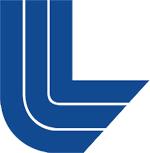

LLNL Report takes a break
The LLNL Report will take a break for the Thanksgiving holiday. It will return Dec. 1.





